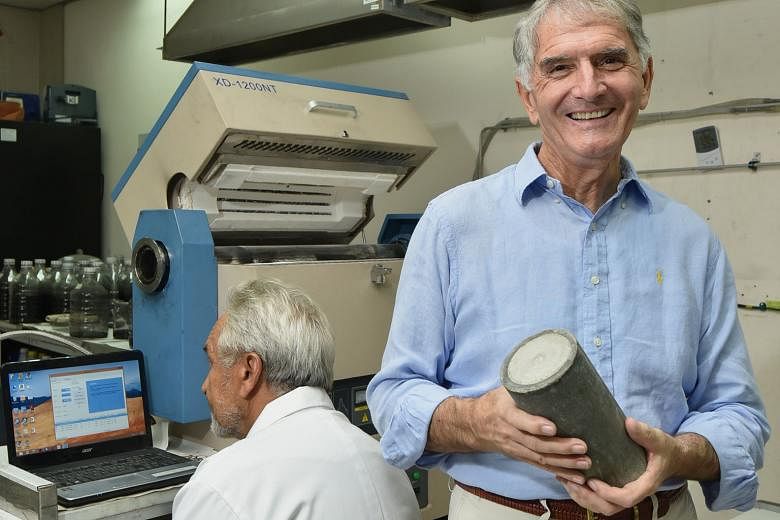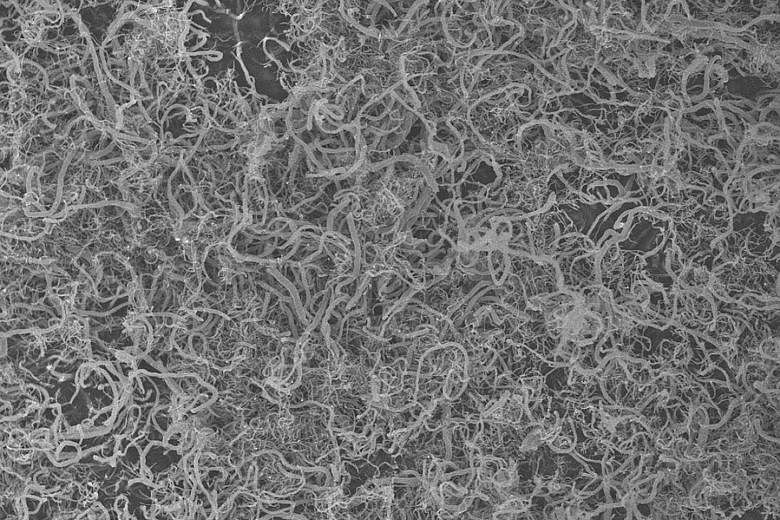In a corner of the Nanyang Technological University (NTU) campus, German-born American Peter Weber is handling fine black powder.
This is no ordinary powder, but the type that can be used to build giant skyscrapers. It makes concrete four to six times stronger without increasing its weight.
Mr Weber, 70, chief executive of ceEntek, a Singapore-registered firm based at NTU, said the black stuff is made of carbon nanofibres, which are 5,000 times narrower than a pinhead. When mixed with the other ingredients of concrete, these nanofibres bind the particles more strongly together, making the concrete less prone to cracking.
Set up in 2010, the company has an office and laboratories at NTU's Innovation Centre and counts scientists from Belarus and the Philippines among its 13 employees. Mr Weber's wife Yana, 50, oversees the day-to-day running of the firm while he tackles the concrete science.
It had discovered many years ago that carbon nanofibres strengthened concrete, but people could not get it to work because the fibres were not distributed evenly in the concrete, he explained. His team at ceEntek figured out a way to suspend the nanofibres in a liquid so that it can be mixed evenly with the concrete.
His team also modified the chemical properties of the nanofibres so that they form strong chemical bonds with the concrete. The carbon nanofibres vary in size, like the particles in concrete, allowing them to pack well together.
The fibres are synthesised from natural gas, which contains carbon, using a special process at between 600 and 700 deg C.
Mr Weber has not filed any patent, because it would require him to reveal too much information about the "trade secret".
The product, which the company calls ultra-high-performance concrete (UHPC), has a "shark skin" surface that is smooth to the feel but with a roughness at the nanoscale that makes it difficult for algae and marine organisms to attach to.
He added that ceEntek deployed UHPC samples at a small test section within the intertidal zone of the HarbourFront Cruise and Ferry Terminal 18 months ago. Singapore Cruise Centre CEO Christina Siaw said initial observations indicated a reduction in the spread of algae and barnacles at the test site.
Another potential use for UHPC is in national water agency PUB's Deep Tunnel Sewerage System, as the tunnel walls need to be resistant to the corrosive effects of sewage, Mr Weber pointed out.
The company is also developing a UHPC with a foam-like structure, that has the same strength as regular concrete, but is half the weight.
Said Professor Tan Kang Hai, associate chair for research at NTU's School of Civil and Environmental Engineering: "Peter's work on lightweight medium-strength concrete represents a significant leap forward in structural engineering."
The firm has been entirely self-funded by Mr Weber so far, with NTU providing some facilities. But negotiations are under way with a major cement company to be a minority shareholder, Mr Weber said.
He added that the firm has made progress in initial research and development, and is now looking to scale up production. He said: "Many people here would rather buy another apartment than give that money for investment in high-tech industry. Out of 10 start-ups, maybe one is really going to be good; the rest are probably going under. But the one can be so successful that it pays for the rest."
Dr Lerwen Liu , managing director of Singapore-based nanotechnology consultancy NanoGlobe, said: "ceEntek's innovation in concrete-making is totally disruptive and creating new opportunities for construction industries and, most importantly, contributing to sustainability."



